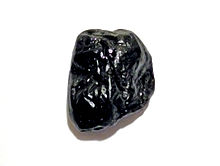- Prune
-
This article is about the fruit trees and their fruit. For the trimming of fruit tree branches, see fruit tree pruning. For pruning of trees and plants in general, see Pruning.
A prune is any of various plum cultivars, mostly Prunus domestica or European Plum, sold as fresh or dried fruit. The dried fruit is also referred to as a dried plum. In general, fresh prunes are freestone cultivars (the pit is easy to remove), whereas most other plums grown for fresh consumption are clingstone (the pit is more difficult to remove).
Contents
Production
More than 1,000 cultivars of plums are grown for drying. The main cultivar grown in the US is the Improved French prune. Other varieties include Sutter, Tulare Giant, Moyer, Imperial, Italian, and Greengage. Fresh prunes reach the market earlier than fresh plums and are usually smaller in size.
Marketing change
Due to popular perception (in the U.S.) of prunes being used only for relief of constipation, and being the subject of related distasteful joking, many of today's distributors have stopped using the word "prune" on packaging labels. Their preference is to state "dried plums".[1]
Uses
Plums, dried (prunes), uncooked Nutritional value per 100 g (3.5 oz) Energy 1,006 kJ (240 kcal) Carbohydrates 63.88 g - Sugars 38.13 g - Dietary fibre 7.1 g Fat 0.38 g Protein 2.18 g Vitamin A 781 IU Vitamin C 0.6 mg (1%) Phosphorus 69 mg (10%) Potassium 732 mg (16%) 1 prune, pitted 9.5 g
1 cup, pitted 174 g
Percentages are relative to US recommendations for adults.
Source: USDA Nutrient DatabasePrunes are used in cooking both sweet and savory dishes. Stewed prunes, a compote, are a dessert. Prunes are a frequent ingredient in North African tagines. Perhaps the best-known gastronomic prunes are those of Agen (pruneaux d'Agen). Prunes are used frequently in Tzimmes, a traditional Jewish dish in which the principal ingredient is diced or sliced carrots; in the Nordic prune kisel, eaten with rice pudding[disambiguation needed
 ] in the Christmas dinner; and in the traditional Norwegian dessert fruit soup. Prunes have also been included in other holiday dishes, such as stuffing, cake, and to make sugar plums.
] in the Christmas dinner; and in the traditional Norwegian dessert fruit soup. Prunes have also been included in other holiday dishes, such as stuffing, cake, and to make sugar plums.Health benefits
Prune juice is made by softening prunes through steaming and then putting them through a pulper to create a watery puree. Prunes and their juice contain mild laxatives including phenolic compounds (mainly as neochlorogenic acids and chlorogenic acids) and sorbitol.[2] Faster results are obtained by heating the prune juice.[citation needed] Prunes also contain dietary fiber (about 6%, or 0.06 g per gram of prune). Prunes and prune juice are thus common home remedies for constipation. Prunes also have a high antioxidant content.[3] In China, the popular summer drink suanmeitang, made with sour prunes, is sometimes thought to have positive effects on acidity in the body.[by whom?]
In popular culture
- Worf, from Star Trek: The Next Generation enjoys prune juice, proclaiming it "a warrior's drink".[5]
- Prunes and prune juice are recurring elements in Frank Zappa's album, Absolutely Free.
See also
References
- ^ Janick, Jules and Robert E. Paull (2008). The encyclopedia of fruit & nuts. CABI. ISBN 0851996388. p. 696.
- ^ Stacewicz-Sapuntzakis, M; Bowen, PE; Hussain, EA; Damayanti-Wood, BI; Farnsworth, NR (2001). "Chemical composition and potential health effects of prunes: a functional food?". Critical reviews in food science and nutrition 41 (4): 251–86. doi:10.1080/20014091091814. PMID 11401245.
- ^ "Oxygen Radical Absorbance Capacity (ORAC) of Selected Foods" (PDF). United States Department of Agriculture. November 2007. http://www.ars.usda.gov/SP2UserFiles/Place/12354500/Data/ORAC/ORAC07.pdf. Retrieved 2009-10-27.
- ^ Mikkelson, Barbara (27 February 2007). "Belle Pepper". Snopes. http://www.snopes.com/business/secret/drpepper.asp. Retrieved 2007-04-05. "Dr Pepper doesn't contain any prune juice, but this rumor has been remarkably long-lived, having been with us since about 1930."
- ^ Star Trek: The Next Generation - "Yesterday's Enterprise"; S03E15.
External links
Categories:- Dried fruit
- Laxatives
Wikimedia Foundation. 2010.


